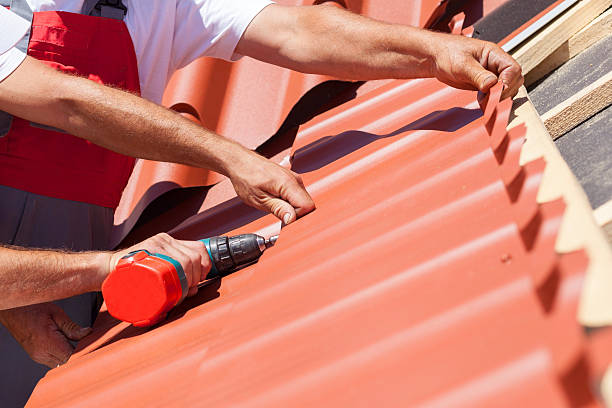Find a licensed Roofer to handle all your industrial roofing needs.
Just How to Assess Various Roof Covering Choices for Your Building Requirements
Evaluating roofing choices for your building needs a comprehensive strategy that takes into consideration numerous aspects such as the planned usage of the framework, neighborhood climate conditions, and material qualities. It is vital to evaluate the advantages and downsides of various roof covering kinds, from asphalt tiles to steel and clay floor tiles, while also considering initial costs and lasting upkeep. Furthermore, recognizing energy efficiency and aesthetic allure can affect your choice. As you ponder these factors to consider, one concern stays: which variables will inevitably assist your option for a sustainable and aesthetically pleasing roof remedy?
Evaluating Your Building's Demands
To efficiently review roof options, begin by extensively assessing your structure's requirements. Begin by taking into consideration the structure's planned use, as various structures might require differing roofing requirements. Household roofings typically prioritize appearances and insulation, while commercial buildings might concentrate on longevity and load-bearing capacity.
Next, examine the neighborhood environment problems that will certainly impact roof covering efficiency. Aspects such as temperature level variations, precipitation levels, and wind patterns can affect product choice and layout. A roof system that stands out in a temperate environment may not do also in areas susceptible to hefty snowfall or extreme warmth.
Additionally, assess the architectural stability of your building. Make certain that the existing structure can support the chosen roof materials, especially if considering larger choices. It is also vital to evaluate any kind of regional structure codes or policies that may determine specific needs for roof.

Comparing Roof Materials
When an extensive evaluation of your building's requirements has been finished, the following action entails contrasting different roof materials. Each material offers unique advantages and disadvantages, making it necessary to align your option with your certain demands and scenarios.
Asphalt tiles are commonly recognized for their affordability and simplicity of setup, making them a prominent option for domestic buildings. On the other hand, steel roof covering, known for its longevity and long life, can stand up to extreme climate conditions yet may feature a higher preliminary investment.
Clay and concrete floor tiles offer superb thermal insulation and visual appeal, specifically for Mediterranean-style design, yet they call for a more robust structural support because of their weight. Timber shakes offer a natural look and excellent insulation homes but might require more upkeep and are susceptible to fire dangers.
Examining Cost and Spending Plan
Evaluating your roof covering choices requires a cautious evaluation of expense and budget considerations. The overall allocate a roof task comprises a number of elements, consisting of product costs, click now labor expenses, upkeep, and potential long-lasting cost savings. It is necessary to establish a clear spending plan prior to checking out details roof check here covering products, as this will direct the decision-making procedure and help you prevent overspending.
Begin by getting quotes from multiple professionals to understand labor prices in your region. Make certain that these quotes consist of all essential solutions, such as elimination of the old roofing, installment, and any kind of added features, like insulation or air flow renovations - Roofing Contractor. Next off, analyze the cost of different roof materials, taking into consideration both first installment prices and anticipated lifespan

Comprehending Energy Effectiveness
Energy performance plays a vital duty in the selection of roofing materials and systems, considerably influencing both power intake and overall comfort within a structure. An appropriate roof covering can boost thermal efficiency, decreasing the demand for heating and cooling down systems, which subsequently lowers energy bills and decreases ecological influence.
When examining roof covering choices, consider materials that reflect as opposed to absorb warm. Light-colored or reflective roofing products can significantly reduce roof covering surface area temperature levels, resulting in lower energy use during hot months. Additionally, proper insulation and air flow are necessary to maximize the power performance of the entire roof. Insulation avoids warm transfer, while ventilation minimizes warmth accumulation additional reading in the attic room area.
Another important variable is the roof system's longevity and maintenance requirements. Sturdy products that require less constant replacement add to long-lasting energy cost savings. The power efficiency of a roof system can likewise be examined with its conformity with well-known sustainability scores such as Power CELEBRITY or LEED.
Taking Into Consideration Visual Appeal
A roofing system's visual charm significantly affects the total look of a building, enhancing its architectural design and boosting curb charm. Roofing Contractor. When reviewing roof alternatives, it is crucial to consider exactly how the picked material, shade, and design will certainly integrate with the existing structure and area. A well-designed roofing can boost also the simplest of buildings, transforming them into aesthetic centerpieces
Various roof products provide various aesthetic high qualities. For instance, conventional tiles might stimulate a classic appeal, while steel roof covering can give a modern, smooth look. In addition, the color of the roof covering material plays an essential function; lighter tones can make a building show up even more roomy, while darker tones may create a cozier setting.
Moreover, architectural elements, such as dormers and eaves, can enhance the roofing's visual impact. It is recommended to seek advice from specialist developers or designers to ensure the picked roof covering option straightens with the general design intent. Ultimately, a roofing system needs to not only give functional advantages yet likewise contribute positively to the building's aesthetic, reflecting the owner's taste and the personality of the surrounding setting.
Verdict
